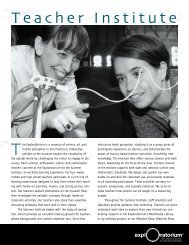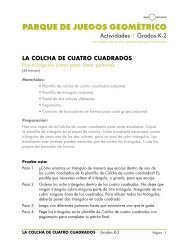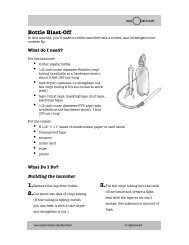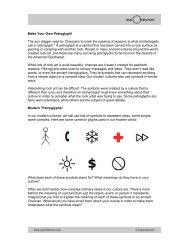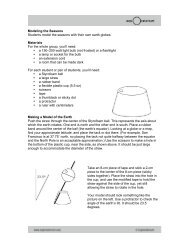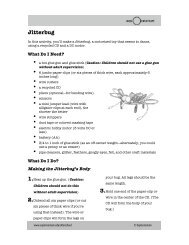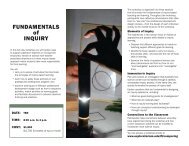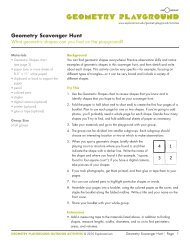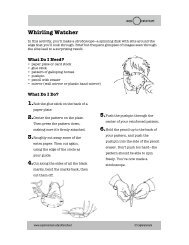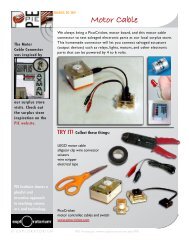Traveling Networks - Exploratorium
Traveling Networks - Exploratorium
Traveling Networks - Exploratorium
You also want an ePaper? Increase the reach of your titles
YUMPU automatically turns print PDFs into web optimized ePapers that Google loves.
GEOMETRY PLAYGROUND OUTDOOR ACTIVITIES © 2010 <strong>Exploratorium</strong><br />
www.exploratorium.edu/geometryplayground/activities<br />
<strong>Traveling</strong> <strong>Networks</strong><br />
What’s the rule that tells you whether or not a network can be “traveled”?<br />
Materials<br />
• playground with painted game<br />
courts (hopscotch, four square,<br />
and so on) or other paved<br />
surface<br />
• chalk<br />
• paper and pencil (optional)<br />
Group Size<br />
small groups<br />
Related Activity<br />
• Solving Playground Network<br />
Problems<br />
Did You Know?<br />
In the 1700s, the people of a<br />
town called Königsberg amused<br />
themselves by trying to cross<br />
each of Königsberg’s seven<br />
bridges (edges) only once to end<br />
up at their starting point. Swiss<br />
mathematician Leonhard Euler<br />
(pronounced “oiler”) studied the<br />
problem and found a way to<br />
prove whether or not the edges in<br />
any particular network could be<br />
traveled only once to complete a<br />
circuit—and showed that it was<br />
impossible to travel the seven<br />
bridges in this way.<br />
Background<br />
There are networks everywhere: computer networks, social networks, and networks<br />
of nerve cells in our brains. <strong>Networks</strong> consist of points (also called nodes)—the<br />
computers, people, and so on—and edges that connect the points to each other.<br />
All networks can be drawn with dots representing the points, and straight lines or<br />
curves representing the edges.<br />
You can find networks painted on playgrounds, such as a four square court<br />
(although you’ll have to add the points or imagine them), and you can draw your<br />
own. In this activity, you’ll try to “travel” some playground networks.<br />
Try This<br />
How to Travel a Network<br />
point<br />
edge<br />
For this activity, we’ll only use networks that are closed. Your goal<br />
is to walk on every edge until you return to your starting point<br />
without walking on any edge more than once. You may cross a<br />
point any number of times.<br />
NOTE: Some networks cannot be traveled. Some complicated<br />
networks can be traveled, but it may be difficult to discover the<br />
correct route.<br />
1. Each group should draw these two networks on the playground. Make each<br />
about a meter across:<br />
<strong>Traveling</strong> <strong>Networks</strong> | Page 1
<strong>Traveling</strong> <strong>Networks</strong> (continued)<br />
GEOMETRY PLAYGROUND OUTDOOR ACTIVITIES © 2010 <strong>Exploratorium</strong><br />
2. Try walking these networks to see if they can be traveled. Figure out a way to<br />
keep track of each edge that you walk on.<br />
3. If you found that one of the networks couldn’t be traveled, try again from a<br />
different starting point. How many times do you think you should try before<br />
deciding that it’s impossible to travel a particular network? Write possible or<br />
impossible next to each network.<br />
4. Identify some networks painted on the playground, or draw some of your own,<br />
and repeat steps 2 and 3 for each network. If a network seems impossible to<br />
travel, you might try starting from a different point, or you might try starting at<br />
the same point but making some different decisions about when and where you<br />
turn.<br />
5. Look for a pattern or rule that could tell you which networks can be traveled<br />
and which cannot be traveled. Do you see anything that all the possible<br />
networks have in common or that all the impossible networks have in common?<br />
(Hint: count the number of edges that come into each point.)<br />
6. If you have time, trade places with another group. See if you can travel any of<br />
the networks they thought were impossible, and vice versa. Or copy some of<br />
the impossible networks onto a piece of paper and try to work them out later.<br />
What’s Going On?<br />
Points in a network can be described as odd or even. Odd points have an odd<br />
number of edges coming into them, and even points have an even number of<br />
edges. A network that makes a complete circuit can be traveled according to the<br />
rules of this activity only if all the points are even.<br />
So What?<br />
Figuring out the most efficient way to travel a network has a number of practical<br />
applications: People who plan the routes for trash and recycling collection, mail<br />
delivery, and street cleaning, for example, use this kind of geometry.<br />
<strong>Traveling</strong> <strong>Networks</strong> | Page 2





